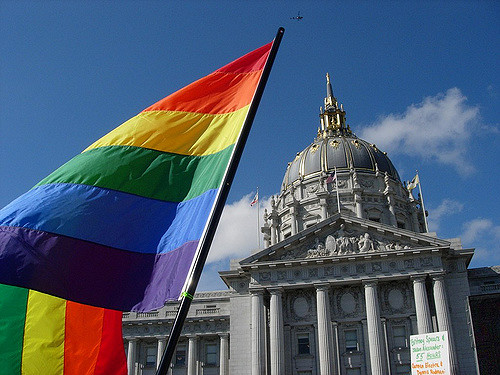
Originally published February 16, 2016
In June of 2015, the United States Supreme Court answered a question affecting millions of lesbian, gay, bisexual, and transgender Americans—by declaring that the right of same-sex couples to marry is protected under the U.S. Constitution and no state may deny that right. Like many previous issues, the gay marriage issue has polarized American public opinion, and so there is the same possibility that a Court decision for minority rights could lead to widespread backlash and outright refusals to obey. That is what happened following the 1954 Brown v. Board of Education decision outlawing racial segregation in schools and in the aftermath of the 1973 Roe v. Wade decision establishing abortion rights. In many states and localities, we can assume that the current Supreme Court ruling for gay marriage may also spark pushback from politicians, religious organizations, and interest groups. This brief draws on theories about backlashes to Supreme Court rulings to suggest how movements for minority rights can respond.
Counter-Majoritarian Court Decisions May Spark Widespread Backlashes
In 1962, legal scholar Alexander Bickel coined the phrase “counter-majoritarian difficulty” to describe what happens when Supreme Court rulings challenge majoritarian interests to further minority civil rights. In contrast to legislative majority votes, such rulings may lack legitimacy in the eyes of interest groups, politicians, and many citizens. A workable democracy needs a judiciary capable of balancing values and interests—but when the courts rule in favor of social movement lawsuits on behalf of minorities, their decisions may be politically vulnerable.Movements fighting for minorities often find it hard to change the hearts and minds of citizens in the majority. This can be an arduous and lengthy process, during which minorities continue to suffer harm. Naturally, movements turn to litigation to obtain judgments from the courts affirming basic rights. However, as constitutional law scholar Michael Klarman explains, securing rights through litigation can short-circuit intermediary efforts to change majoritarian ideas and institutions. In the current instance, lesbian, gay, bisexual, and transgender Americans need equal housing and workplace protections that might have been secured before or along with marriage equality if other paths beside court cases had been taken. It is fair to ask whether democratic discussions have been short-circuited—whether a litigation strategy deprives other political institutions, more majoritarian than the courts, of chances to act on behalf of minorities.
Continuing polarizing can result from skipping steps, as Klarman shows. In the aftermath of Brown v. Board of Education, local and state progress toward racial desegregation of schools came to a halt. The Supreme Court’s intervention essentially froze such democratic processes of change. Likewise, at the time of the Roe v. Wade ruling, the tide was turning toward abortion rights at the national and state levels. The Court’s decision instantly polarized the debate and helped spark a national counter-movement that remains highly active today.
The Supreme Court Cannot Enforce Its Own Rulings
Years ago, political scientist Gerald Rosenberg set off scholarly controversy by arguing that the Supreme Court is a “constrained institution” rarely able to further genuine social reform. The Court can only go a limited way toward affirming civil rights; it is not independent of surrounding political forces and has few enforcement tools at its command. Because the Supreme Court relies on the executive and legislature to carry through its rulings, broad social change will not occur absent at least tacit acceptance from the other branches. Given these realities, Rosenberg suggested that the “lure of litigation” could turn into a dead end for social movements.
Supporters of Rosenberg’s argument often point to Brown v. Board of Education. This was no doubt a landmark ruling with wide reverberations, but the year following the decision the Supreme Court issued another ruling allowing local school districts to obey with “all deliberate speed,” allowing for fragmented, slow, and limited enforcement of desegregation. With many localities resisting, President John F. Kennedy had to deputize the national guardsmen to desegregate the University of Alabama in 1963; and Congress had to pass the Civil Rights Act of 1964 to enforce school desegregation nationwide. As Rosenberg argues, true social change was accomplished only after the other branches of government joined the Supreme Court.Implications for Current and Future Rights Movements
For many movements fighting for minorities, the “lure of litigation” is often inevitable. Basic rights claims may simply have to be litigated. But movements must be prepared to cope with backlashes and maintain momentum if they succeed at the Supreme Court.
- To continue to represent their communities, movements must plunge into the legislative debates certain to happen when a Supreme Court decision for minority rights is announced. Opponents will be mobilized and use positions of authority to limit and circumvent the legal rights victory. To defeat opponents who claim they speak for “the will of the people,” movements must present data showing otherwise and continue making appeals to the public.
- Rights movements should have actionable strategies to engage in all venues of democratic government, pursuing legislative and administrative actions at the same time as court cases. And movements should celebrate Supreme Court victories quickly and then move on to lobby for further supportive legislation and regulations.
Research for this brief was drawn from Michael J. Klarman, “Social Reform Litigation and Its Challenges: An Essay in Honor of Justice Ruth Bader Ginsburg,” Harvard Journal of Law and Gender 251 (2009): 251-302; and Gerald Rosenberg, The Hollow Hope: Can Courts Bring about Social Change? (University of Chicago Press, 1991).

 Research to Improve Policy: The Scholars Strategy Network seeks to improve public policy and strengthen democracy by organizing scholars working in America's colleges and universities. SSN's founding director is Theda Skocpol, Victor S. Thomas Professor of Government and Sociology at Harvard University.
Research to Improve Policy: The Scholars Strategy Network seeks to improve public policy and strengthen democracy by organizing scholars working in America's colleges and universities. SSN's founding director is Theda Skocpol, Victor S. Thomas Professor of Government and Sociology at Harvard University.